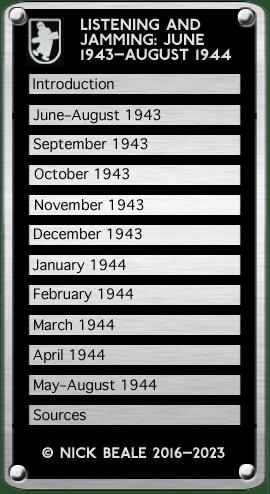|
The Kommando added two Ju 188 F-1 to its strength on 6 September, W.Nr. 280008 and 280010. The provision of this type had first been talked about at least three months before (see above) and one of these machines made a two-hour practice flight over the sea during the afternoon of the 15th. Activity was stepped up considerably, with He 111 flights on the 2nd, 4th, 6th (out over Arcachon at 2100, back at 0500), 8th and 9th (this last apparently involving a Heinkel coded “C”). These aircraft were now being described as “associated by III./KG 40.” On the 10th though, two He 111 were active, taking off 30 minutes apart from 2110. One of them reported enemy fighters at 0443 on the 11th and “fighters passed” 20 minutes later; both had landed by 0700. A similar double sortie was planned for the 12th but there was no W/T traffic to confirm it took place. To supplement Rastedter’s quest for electronic intelligence, the Luftwaffe was anxious to obtain information from prisoners involved in operations over Biscay. On 5 September U-boat authorities in Norway sent this signal: The GAF [Luftwaffe] Operations Staff is greatly interested in the bringing in of the crews of enemy a/c shot down over the sea (especially over Biscay). So far only the crews of a/c operating over the land have been brought in. The next night, Naval authorities at Royan announced that an He 111 was to take off at 2100 on an operation, crossing the coast at Arcachon and returning over the same place for a landing at around 0500. The single He 111 airborne on the 13th appears to have suffered technical trouble since it broke off its flight 4½ hours early and returned to Bordeaux. Operations were announced for the 14th, 17th (this aircraft was heard homing on base), 18th (a position report and landing time were intercepted) and 19th (aircraft ”M” was heard homing on Bordeaux).
The Kriegsmarine’s 8th Destroyer Flotilla (Kapitän zur See Hans Erdmenger) was on exercise on 20 September. Fw 200s and Ju 88s of KG 40 had taken part (Hptm. Walter Rieder, 8./KG 40’s Kapitän, had requested a meeting the previous week with the flotilla commander) while Ar 196s from 5./Bordfliegergruppe 196 screened against interference from hostile submarines. On the second, besides the normal night flight, an He 111 was due to make a low-altitude flight out over the Bay from 0920 while three Fw 200 and several pairs of Ar 196 were also involved before the exercise concluded that evening. At 2330 GMT on the 21st, Rastedter was told that “operation will take off if possible by 2359 hrs.” but 15 minutes later the Kommando advised that take-off had been aborted by a broken tail wheel. The 8th Destroyer Flotilla carried out its exercises according to plan. The flotilla returned and dropped anchor off Le Verdon and in Royan roads. [The Flotilla Commander] reported that the following experiences were gained: 1. Results obtained in nine daylight and six night runs were handicapped by … the low efficiency of radar location gear. 2. Night attack practices with the predictor “40” most Impressively showed the superiority of the Air Force location equipment in night attacks. The exact position of the planes overhead could only be gauged by the[ir] recognition lights. Owing to too great an angle of elevation no results were obtainable by radar and it was therefore impossible to put up a defence. War Diary, Kriegsmarine Staff, Operations Division, 21 September 1943 Normal night patrols were intended for the 22nd, 23rd and 24th, after which no further activity was confirmed before the end of the month although there was “one unexplained flight by two Ju 88s” from Bordeaux on the morning of the 26th. In an undated, handwritten note from the second half of the month a British analyst, noting the early Fw 200 operations and the switch to He 111s in July, went on: It has subsequently been assumed that all night flights from the Bordeaux area, which have continued fairly regularly, are ASV security flights of a rather strange type. [A prisoner] however, spoke of an He 111 being used by III./KG 40 for Y purposes — to intercept CC [= Coastal Command] traffic … It looks from this as if the previous stress on the ASV part of the flight may be wrong, and that the real purpose is to intercept British (and American) wireless signals, to which it is known that the Germans attach considerable importance. By 25 September, British Intelligence had built up this picture of the Kommando: Detachment Rastaedter … has now been mentioned twice under the command of Flf. Atlantik, apparently at Bordeaux. As an Obltn. Rastaedter is known to have been associated with Det. Koch in the Mediterranean, the obvious inference is that Detachment Rastaedter is the ASV He 111s associated with III./KG 40. Against this, Det. Rastaedter received 2 Ju 88 [sic] F-1s on 6/9, apparently some special type of a/c, as their works numbers were 0008 and 0010. On 23 and 24/9 (and again on 26/9), there were two operations from Bordeaux, each by 2 Ju 88s taking off about 4 am for a flight lasting three hours. These were not of 15./KG 40, and may well have been the Ju 88 F-1s of Rastaedter. Nothing further is known about the flight. Another possibility is the flying Y station, reported by P/W … continued on next page …
|
|||


